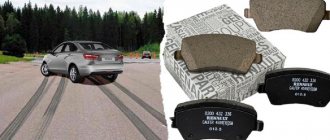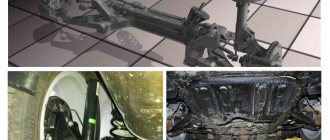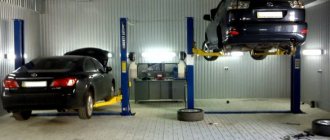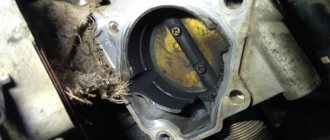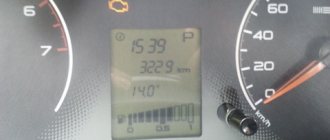Lada Vesta brakes
Disc brakes are installed on the “cross” version with all engines. The “sport” configuration and other ordinary versions (sedans and station wagons) with a 1.8-liter engine. Regular Vesta cars with a 1.6 liter engine are equipped with rear drum brakes. Previously, wheels were not common on VAZs, and were most often installed on sports cars - Grant and Kalina sports versions.
Vesta's brakes work great, although their action is typical. At first, the pedal feels “cotton”, but this helps to control the pressing force. There is no such disgusting moment: we lightly touched the pedal - the machine stood up like a stick! Slowing down occurs smoothly. When you increase the pressure on the pedal, the car slows down perfectly. If we compare it with the Lada Kalina, then with a slight exaggeration we can say that it does not slow down at all. The difference is quite big.
Minuses
Drivers say that the front discs wear out very quickly on all versions of Vesta. You have to change them at 50 thousand km or earlier.
This depends on the operating mode. If the car is used in a town with rapid acceleration and braking, then the wheels can be worn out within 30,000 km. If the driving is mainly suburban and measured, then you can drive 150 or more thousand km. But you shouldn’t make a big deal out of this, because the main thing is for the car to brake well. My car is 6 months old, I have driven 6000 km.
If you have already changed the wheels on your own car, share your opinion in the comments on what mileage it happened at. If they are not worn out yet, then write what kind of machine you have and how worn the discs are.
Clutch faults
Vesta, depending on the type of transmission, may have a different drive. Accordingly, their problems may be different.
Problems with the hydraulic clutch
The brake fluid enters the working cylinder from the master cylinder through pipelines. The following malfunctions occur with these two main parts of the mechanism:
- excessive wear of rubber cuffs in cylinders;
- brake fluid leakage (lack of tightness at the pipe connections);
- damage to cylinders, pipelines, etc., which causes cracks to appear.
The hydraulic drive is highly reliable, but it can also fail if air gets into the system. The main sign of airing: incomplete disengagement of the clutch. Because of this, the gears will either be switched on with great difficulty or will be almost impossible to do. Typically, air enters the system when the level of brake fluid in the master cylinder reservoir is critically low, or due to loss of tightness. To troubleshoot problems, it is enough to bleed the system; a special fitting is provided for this.
There is no need to adjust the hydraulic clutch drive while the vehicle is in use.
The durability of the system depends on the driving style of the owner and operating conditions. A working clutch will not slip and fully transmit torque from the engine to the gearbox when the pedal is released. When the pedal is depressed, the transmission must be completely disconnected from the power plant.
Knock of calipers and nasty sound
If you knock on the wheel, you may hear a knock from the caliper. On my car they don’t knock, at least not yet. There are also complaints about the annoying sound heard from the disc brakes at the rear. My car has it too. The sound is like a piercing, drawn-out howl.
It is not heard all the time. If you were driving around a town, braked, drove backwards and began to slow down. At this moment a disgusting sound is heard. Where this sound comes from is unclear. There is no noise when moving forward or braking.
This affects the style of the car. When choosing a car, a client at a car dealership on a test drive may give up on the purchase after hearing the disgusting sound of the brakes. Naturally, this does not affect the speed; the fault can be eliminated by replacing the brake pads. But then a question arises for AvtoVAZ: “Why should Vesta owners change the pads on the newest car?”
In this case, a replacement has to be made with non-original pads. If you install factory ones, this will not change the situation.
On economical foreign cars, owners try to replace them with unique spare parts after the pads wear out. If they install non-original ones, it’s just to save money. We are buying the latest car. And in order not to listen to nasty squeaks and squeaks, you must replace the parts with non-original ones!
↑ Cost of disc brakes and work to replace them
Despite AvtoVAZ’s agreed decision to install disc brakes on the Lada Vesta at the front and drum brakes at the rear, there are cases when this design is not a priority. These are the following options:
- This refers to the sports modification of the Lada Vesta sedan;
- this is not a production model, but a concept car;
- the standard car was modified to compete in the World Touring Car Championship (WTCC).
In all of these cases, disc brakes will be installed on the Lada Vesta, and this modification will be completely legal.
Important. Replacing standard drum brakes with disc brakes for a regular car, if it is not planned to be used in high-speed races or championships, is unlikely to be a good alternative to the factory equipment
The drum braking system is considered more reliable in urban conditions, since it is almost impervious to weather conditions. Moreover, disk systems are less protected from pebbles, dirt, and slush flying from under the wheels, which adversely affects their performance.
On average, both types of brakes - disc, drum, regardless of their placement, rear or front brakes for the Lada Vesta are equivalent in their effectiveness. Professionals will be able to appreciate the difference, and only at speeds of 120 km/h and above. If you really want to, you can still upgrade, but it will not be cheap, especially since the modernization will have to be legalized.
How to solve the issue without substitution
I decided to fix the problem using the other method that was suggested to me. I tried to swap the pads and grind them down on their edges. If this doesn't help, I'll create a replacement.
I decided to apply all the tips I found on the Internet. I took off the pads, cleaned everything, ground down their edges, and swapped the inner ones with the outer ones.
I bought two types of lubricant:
- For the non-working surface of the pad.
- For the surface that comes into contact with the caliper.
I collected everything for the space, but there are huge doubts about such actions. As long as I drive for a few days, everything is fine. If the brakes start squeaking again, then I will change the front and rear pads.
If your machine makes similar sounds, be sure to write in the comments. AvtoVAZ is probably watching reviews of its products and listening to the views of the owners of the Lada Vesta.
Soon there will be an update of the car and its restyling. I would like the factory engineers to remove all the bugs that exist in the newest cars.
Source: xn—-21-43dabppn4d4dn.xn--p1ai
Description of replacing rear pads on a Chevrolet Cruze
In order for the replacement of brake pads to be successful, it is recommended to follow the sequence given below.
- By placing a jack under a special groove, you need to lift the car from the side from which the brake pads will be replaced.
- Place the stop on the jacked side.
Remove the wheel.
Using the “10” and “13” keys, unscrew the two bolts on the caliper. If they cannot be removed from their place, it is recommended to treat the seat with a penetrating lubricant, for example, WD-40.
Move the caliper to the side. To prevent damage to the brake line, it is recommended to secure it with a wire or place it on a support.
Carefully pry the pads with a screwdriver and remove them.
Lubricate all guides. You must first remove all old grease using a rag.
- Unscrew the brake fluid reservoir cap.
- Using a grinder wrench, rotate the brake cylinder clockwise and press it into the seat.
Install the pads into the caliper
It is important to be careful not to confuse the right with the left. Reinstall the caliper.
Tighten the fasteners. For these purposes, you will additionally need a “19” key.
- Clean everything from dirt using a wire brush.
- Reassemble everything in reverse order.
- Similar actions must be performed for the second wheel.
- Bleed the brake system from air.
Review: Car Lada Vesta SW Cross – Did not live up to the Hopes and Expectations placed on it.
But I really thought that the VAZ - TAZ had changed, but no. 2 points is still the maximum.
I fell for the functions of the Car. And by the way, the car on the TEST drive is really better than what you buy.
Cons: 1. Hard CHEAP plastic that scratches. like in China auto. They could create a soft one for that kind of money. 2. Creaks and crickets in the plastic when the car is moving. 3. Engine 1.6 Dumb and gluttonous on Benz 4. The car makes an alloy clicking sound every time you start the car when it’s cold. What kind of innovation is this? 5. The car eats more Gasoline than declared by the Manufacturer, on average 11-12 liters. and this is still in the summer in Gorodok. what will happen in winter XZ l. 15 and this is on a 1.6 liter engine. 6. The car stalls when driving, especially at small stops, and then jerks sharply and stalls again. they said this is the highlight of the firmware and this is normal, but on foreign cars there is no such thing. 7. The steering control is terrible, you have to constantly steer a little to the left and a little to the right. 8. When you engage reverse gear, the rumble from the pads is VERY STRONG. By the way, this happened in a Skoda, but very occasionally and not such a powerful noise. 9. Mechanic's box. Well it's just just ADDDDDD. Crunches constantly works aggressively. there is no hint of smoothness, like on foreign cars. The box is from the 80s. 2nd gear in particular kills. oh, and the rear one sometimes doesn’t engage even after 5 tries, and yes {the instructions} with waiting 3 seconds don’t help))) 10. Disembarkation of the driver. terrible at height 184, I just [censored] adjust, as a result my leg gets tired. On foreign cars everything is fine, I sat down and drove off, but this is a TAZ 11. The clutch pedal is tight. It’s just shit, well, it’s really affordable from China. Why is the clutch soft and smooth on foreign cars. 12. Beating and knocking of the steering wheel on crushed asphalt joints or crossing railway rails or tram tracks. + plastic rattles next to the steering wheel. 13. The rear wiper turns on for some reason when reverse gear is engaged. 14. Cheap frame wipers from the factory. which by 3 days became like a comb. 15. When changing the oil in the Box in the MECHANICS, shavings and alloy crumbs are combined. I advise you to change the oil at 2-3 thousand. By the way, for the Dealer this is the norm, this is how everything must be, and yes, there is a magnet that will attract these shavings and crumbs of the alloy. 16. There is no FUNCTION on the steering column switches to turn on the wiper; flap the wing once. o5 saved? 17. The radio tape recorder becomes dull already at 0 and -3 degrees, the screen will thaw for about 30 minutes and it turns on from time to time 5-10 times. 18. The car is not worth its own 800 thousand. Let's face it, after a foreign car you get into a Trough or a cart, whichever suits you better. 19. Reviews of 5 points are really far-fetched. VAZ has bots that write all these reviews + companies that write reviews for money, and yes, there are a lot of such companies at the moment. Or those who have NEVER driven a foreign car in their life. And yes, what is currently on the Veil are those functions. and arose only at the moment in 2017 when they were already available on foreign cars in the 90s - 2000s
How to remove extraneous sounds from the clutch pedal on a Lada Granta?
As everyone knows, the clutch cable drive circuit on the Lada Granta is equipped with an automatic tensioner (wear compensator) of the clutch cable. As conceived by the designers, such a scheme simplifies the operation of the car; the owner no longer needs to independently adjust the gap on the clutch fork and adjust the clutch pedal. But nevertheless, problems still occur. Most often, assemblers are to blame for incorrectly setting the working gap on the clutch fork and skimping on lubricants during assembly. As a result, we get extraneous noise when working with the pedal.
In order to deal with the problem, you need to carry out a set of simple measures. First, we need to adjust the clearance on the clutch fork. This can be done either with or without removing the air filter housing.
If you decide to remove the filter housing, then you need to: remove the cold air intake pipe and the air supply pipe to the receiver, remove the wiring from the mass air flow sensor, disconnect the wiring harnesses that are attached to the housing and, releasing the rubber stops, remove the housing from the engine compartment .
To set the gap on the clutch fork, you need to pull the clutch cable all the way in the direction of travel of the car, and by unscrewing and wrapping the plastic wing, set a gap of 27 millimeters between the wing and the clutch fork.
After we have set a guaranteed working gap on the fork, we need to lubricate the elements in the pedal assembly. WD-40 will do the job. We need to apply lubricant to the clutch bushing and the plastic wear compensation ratchet. Also, if necessary, you can apply lubricant to the clutch cable sheath.
By performing this simple series of actions, you are guaranteed to get rid of noise when operating the clutch pedal and set the mechanism to the optimal level of operation. If the noise remains when you press the pedal, I advise you to contact an official service center, since the presence of such noise after all the necessary work may be a signal of a malfunction that will require replacement of the cable or pedal assembly.
Vile rumble when reversing
I read the forum - I don’t see anyone having this problem, but on my cross (1.8, AMT, 6500 km) when moving in reverse, at times there is a sound as if a brake pad or something else was rubbing against something iron, while emitting not a crackling sound, but an ominous roar. Who came across it? Haven't been to the OD yet. I'm waiting for scheduled maintenance.
The last time was ruled by Yuri Chub; 03.08.2018 at 11:41.
They wrote about this somewhere on the forum. This also happens to me from time to time (1.6 MT). What is this is unclear =)
1.8 MT. The same garbage. I wrote this somewhere on the forum. The feeling that either the pads do not come off completely, or the calipers are the brain (the central section of the nervous system of animals, usually located in the head section of the body and is a compact accumulation of nerve cells and their processes)
have. Because if you press the brake a little during the rumble, the rumble is lost. I told the dealer, but I couldn’t show it, because this doesn’t happen all the time. Most importantly, it happened in the winter, even less often in the summer. Therefore, the dealer did nothing failed. At the same time, it doesn’t matter if you go backwards in gear or just roll downhill in neutral - the sound is still there.
The same bullshit happens from time to time, I press the brake quietly and it goes away. I don't think the pads are coming off completely
Rear disc brakes. This means there is a protective case. A pebble may fall under it, or something has already “fell off” and is rubbing. Sometimes it will grind forward, then it will grind backwards and fly out. It is impossible to see what is under the casing - it covers the disk. Lift the wheel and spin it. If yes, then remove the wheel, then unscrew it, discard the caliper, unscrew and remove the brake disc.
. Naturally, if the block does not rub with iron. but unscrew and discard the caliper and it will be clear.
Last time was ruled by Vik; 08/22/2018 at 22:49 . Reason: clarification
A couple of times this happened to me when I started moving backwards. And now it has come forward almost at a stop. There's something wrong with the pads. Nothing could get into the defense. The mileage is only 4500. What is there, the springs are pressing for sure. We'll have to move back to the hands and watch.
Later, tell me that you found it. I was unable to present this malfunction to the officials. Because before this the machine was always parked in the box and after a warm room the malfunction did not appear
Source: sw-cross.ru
Noise when braking that is not related to the brakes
https://youtube.com/watch?v=cGSX8VyhJI8
https://youtube.com/watch?v=cGSX8VyhJI8
There is another noise that can occur when braking. It is noteworthy that it is not directly related to any malfunction. Technically, this noise has to do with the brake discs. If so, we should mention this noise in our article. By the way, many drivers, having heard noise associated with this problem, think that there is a malfunction in the car’s brake system. So what is this noise?
If your car makes a scraping sound when driving or turning that sounds like something akin to a tin can rattling, you may have caught a rock in the road that has become lodged in the brake system. Most often, stones get lodged in the space between the brake rotor and the backing plate, resulting in a terrible sound. To get rid of it, simply remove the stone. Sometimes the cause of the noise can be the brake disc backing plate, which, bent, touches the disc, scratching it.
Another way to remove a stone stuck behind a brake rotor is to bend the backing plate slightly as shown in the video below:
We hope that all the information provided here will help you diagnose the noise that you think is coming from your car's brakes. Yes, some of the methods presented in our article are a little unconventional, but this is normal when it comes to car repairs. Remember that there is no universal method for car repair.
There is always a better way to find the cause of the problem and fix it. And don't be afraid to experiment and try new methods to fix car problems. As a wise man once said, “If you do the same things over and over again expecting different results, you must be crazy.”
Rattles and creaks in the front suspension
A dull sound, as if the struts are touching plastic, or a creaking sound reminiscent of rubber rubbing. The reason is the poor quality of the stabilizer bushings (No. 8) or insufficient lubrication of the muffler mounts .
It is enough to lubricate the gingerbreads (muffler mounts) with grease. There is no point in lubricating the rubber bushings of the stabilizer, because... this is not enough for long. You can solve the problem of front suspension squeaking like this:
- replace the standard stabilizer bushings with polyurethane bushings (catalog number: 17012680).
- install analogue bushings.
- slip a piece of rubber under the bushings (see video below).
- Since February, AvtoVAZ has been replacing the stabilizer bar of the old standard with the newest one under warranty.
Question to AvtoVAZ: When should you solve the problem of squeaking bushings? The newest cars from October-November continue to creak.
Answer: Improvements were introduced (replacement of rubber, lubricant) at the end of November 2016.
A knock in the front suspension may occur due to wear of the stabilizer struts (No. 7) (replacement), which should be replaced with new ones. This option is discussed in the video:
Also, knocking from the front of the car can come from the upper engine mount or from the brake caliper.
Knocks, crunching in the rear suspension
In the rear suspension, knocking is eliminated according to AvtoVAZ's instructions. You need to remove the rear shock absorber strut and slide a washer under the upper support (No. 5).
It should be noted that after such modification, a gap appears between the support and the body, into which dirt can get. To eliminate this, it is recommended to install a gasket according to the following dimensions:
What else could squeak?
Modern cars have disc brakes on the rear axle, which does not eliminate noise. In some cases, the use of counterfeit pads may be the source of these sounds. There may be solid particles in the friction material of the pads, which will cause squeaking.
There are products in which a special layer of material is installed; when it comes into contact with the brake disc, it emits a signal notifying the driver of the need to replace the pads. Sometimes such sources can be the guide bushings of the brake cylinders of disc brakes. In this case, you need to clean them of oxides and lubricate them with anti-squeak grease.
Fans of driving in extreme conditions are faced with the problem of overheated brake discs. In the case when their thickness approaches critical, they can “lead”, which will also lead to the appearance of unpleasant sounds.
We tried to explain in accessible words the reasons why there is a creaking sound in the rear wheel when driving. Of course, these are not all possible sources of its occurrence, but knowing the search algorithm, you can gradually find the problem and eliminate it.
Creaking noise when reversing the vehicle
The Lada Vesta sedan, which opened the newest chapter in the history of AvtoVAZ, has been on sale for 18 months, and during this period of time it has not only managed to show all the “childhood diseases” that inevitably make themselves felt when the newest model is released, but has also gone through a series modernizations to remove all tasks. Did it work out?
It is curious that virtually all the tasks of the “Vesta” - as if by choice - are combined with nasty squeaks, rustles, crunches and other unnecessary sounds that force the owners to swear and call their own old car, in general, an old ungreased cart. At home are the problems encountered in the version with a manual AMT gearbox and a brand new 1.8-liter engine, but we already mentioned this when we studied the diseases of the Lada Xray. As for unnecessary sounds, AvtoVAZ states that all these squeaks have been found and corrected, so that they no longer have to exist on the newest cars. So what actually creaked?
Stabilizer bushings creaking
Until recently, the creaking of stabilizer bushings on Vesta was considered almost the most widespread problem: almost nine out of 10 owners complain about annoying sounds when driving over bumps. Instead of original bushings, analogues from other brands were prescribed, rubber was replaced with polyurethane, “non-original” rubber bands trimmed and modified locally. This often helped for a while, but after several thousand kilometers the sound often returned again.
The noise was caused by an insufficient amount of lubricant and poor properties of the bushings themselves. Official dealers could lubricate or change the part under warranty, but this usually only helped for a short time. But both dealers and the manufacturer claim that a solution has already been found: the composition of the bushing material has been improved, and on the newest Vestas the creaking has already been overcome.
Creak of stabilizer struts
And again the words “creaking” and “stabilizers” end up in the same sentence. Now we are talking about the stabilizer struts, which also began to creak and knock quite noticeably when driving over uneven surfaces, even at very short distances.
The reason for the creaking was hidden in the ball joint liner, which began to rotate and play, causing unnecessary sounds. Measures to solve the problem have already been taken: configurations were made to the system, the ball joint body was modified, and now the liner is fixed firmly and does not make unnecessary sounds.
Creaking and crunching when turning the steering wheel
We continue to listen to the Vesta squeaks and move to the front shock absorbers. It was here that the source of another type of squeaks and rustles settled down, which often appeared when turning the steering wheel, especially in wet weather. The whole point is again in the rubber band: the gasket in the upper part of the shock absorber, separating the spring from the support bearing, could at times touch the support bearing itself. This was the reason for the nasty sounds.
In general, this source of sound has already been “muffled”: the manufacturer adjusted the dimensions of the rubber gasket and changed the composition of the material from which this gasket is made, which helped to overcome the noise.
Rear shock absorbers knocking
In the end, the extreme source of squeaking in our review is now in the rear of the car. Until recently, the knocking sound of the rear shock absorbers when driving over bumps was also a “calling card” of almost all Lada Vesta models. In this case, the prerequisite was the upper support of the shock absorber, or more precisely, the rubber hinge located in it.
The rubber joint was replaced with the hardest and most “tenacious” analogue, made from a different consistency composition. Therefore, again, the resistance of the rear shock absorbers to Russian roads has increased, and excessive noise should no longer appear on low mileage on the newest Vestas.
Glass scratches
The last one on the list of solved problems has nothing to do with knocking, and even here it didn’t work out without tires! Owners of Lada Vesta often noticed that quite noticeable abrasions and scratches remain on the front windows if they are lowered and raised.
Official representatives were often approached with a problem given to us, and its essence was hidden in the window seal, which turned out to be very hard and fit very tightly to the glass - hence the abrasions.
In general, it is worth recognizing that the manufacturer was one of the first to solve this problem, long ago and quickly: firstly, the rubber composition of the seal itself became softer, and secondly, its profile changed in such a way as to give the glass a little more “freedom”.
Obviously, the owners of classmates and competitors can gloat and be completely convinced that they literally made the right choice and purchased the most reliable and problem-free machine. But there are no perfect cars, and the fact that your favorite model has not yet appeared in this section for us means only one thing: we just haven’t gotten to it yet.
Thank you for sharing the link to this page!
I drove 480 km and found a nasty squeaking sound from the rear brake pads, which turned into a rumble when reversing. After researching the issue, I realized that there was a problem with the brake pads. Also, the unique brake pads have been reported to be very hard by people and can lead to excessive wear on the brake rotors over time. I don’t see any point in changing the pads at the dealer because... They will put exactly the same ones. The cost of an unusual set of rear pads at the dealer is approximately $35 and the cost of labor to replace them is about $20, if this is important to someone. Therefore, I decided to purchase a full set of pads (front/rear) from Lukas.
Article number of front pads LUCAS/TRW GDB3332
— cost per set is about $27 Article number of rear pads LUCAS/TRW
GDB1384
— cost per set is about $20
Good day! When driving in reverse, with the clutch depressed and the gear engaged, a rattling sound is heard. When driving in reverse with the gear (reverse) engaged, there is no sound. When driving in reverse with the gear off, there is no sound either. what could this mean? The dilemma is already a year and a half old, the car is 2.
Disadvantages of Lada
Lada Vesta left the assembly line not long ago and not all warranty workshops have experience in solving problems like how to eliminate knocking noise that occurs in the suspension. The manufacturer constantly maintains contact with the service station and enters configurations into the system. Let's look at possible faults and ways to eliminate them in the front suspension of the Lada.
A brand new car can upset car enthusiasts almost immediately. There is a nasty squeaking and knocking noise when passing speed bumps. Upon analysis, it turned out that there was a problem in the bushings of the anti-roll bar.
It is not recommended to lubricate them with grease; they will not creak, but for a very short period of time, so they only need to be replaced. They can be modified polyurethane from Niva Chevrolet. The bushing has catalog number 17012680. After replacement, the creaking sound is lost.
You need to know that these are not all tasks; a corresponding knock may appear in front on the right.
This is typical when the free play of the right ball joint is increased. The replacement is done together with the suspension arms assemblies. AvtoVAZ supplies them complete with a ball joint.
Front suspension of the Lada Vesta The main disadvantages that arise in the front part of the Vesta, which may cause the car to creak or rattle:
- Grinding noise in the anti-roll bar;
- The right ball joint is faulty, it starts knocking;
- The stabilizer links begin to rattle.
It is recommended that all these shortcomings be eliminated at AvtoVAZ dealerships.
When driving on an uneven road, you hear a dull knock on small bumps or a sound reminiscent of rubber friction. This problem can be eliminated by lubricating the Vesta muffler mounting with grease. The creaking of Vesta's front suspension may be due to worn out struts.
To eliminate the defect, you just need to replace them with new ones, the problems with the suspension will be solved.

